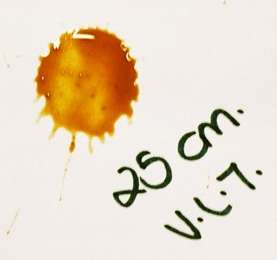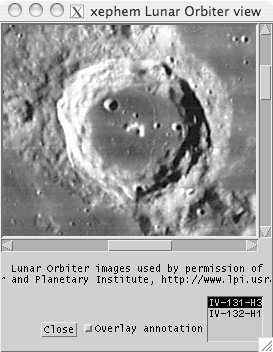April 20th, 2005

- recipe: 300ml of milk and three tablespoons of treacle – warm milk over electric hotplate in milk pan. Spoon treacle in and stir well.
- looks lumpy but dries (in a few days) really convincingly
- Students set up a dissection board or similar with some wall paper afixed – set the board at known angles
- drop the simulated blood a number of times at each angle
- replace the paper with a new sheet and set aside to dry (we used prep room shelves)
- set board to a new angle and repeat
- cover range from roughly 80 degrees to 10 degrees at 10 degree intervals
- use length of board and height of end as acurate measure of angle rather than rely on a small plastic protractor
- test the relationship angle = arcsin(width/length) for the elliptical stains
- low angles – stains almost circular
- high angles – stains take on secondary drop patterns
- intermediate angles – angles estimated from blood stain shape within 2 or 3 degrees of actual angle but always overestimating…
- see blood spatter pattern analysis in bodmas for references
- Thanks to Paul S, Helite, Terry, Jo, Vicky, Louisa for research, recipes and focus on this one

Posted in Maths | Comments Off
April 20th, 2005
Paul Graham quoted on Daring Fireball in a wonderfully named article Point, Counterpoint: Mac OS X Is Great for Fortysomething Unix Hackers – the title being very close to home.
“In 1994 my friend Koling wanted to talk to his girlfriend in Taiwan, and to save long-distance bills he wrote some software that would convert sound to data packets that could be sent over the Internet. We weren’t sure at the time whether this was a proper use of the Internet, which was still then a quasi-government entity. What he was doing is now called VoIP, and it is a huge and rapidly growing business.”
I wonder if Neal Stephenson has considered returning to Apple hardware since his In the beginning was the Command Line and it’s hymn to emacs. We are all getting old. The youngsters click mice….
Posted in Notes | Comments Off
April 20th, 2005

- xephem CD-Roms arrived from US today, about a week after I ordered the package.
- The second disc makes the entire Lunar Orbiter photograph collection available to xephem
- Click on a lunar disc (viewable up to x6 scale) and bring up the feature name
- Apple-click to bring up a dialog box with information
- Click a button in the information dialog to load the appropriate Lunar Orbiter photo
- Nice red overlay provides feature details and crater names
Alas, no interactive search on the list of Lunar features… The Digital Lunar Orbiter Photographic Atlas of the Moon does allow searching by feature name, coordinate or by photo number.
Posted in Notes | Comments Off
April 19th, 2005
Enchanted Learning is a Web site with a large number of simple resources produced by a teacher(?). A colleague uses this Web site for quick lesson ideas when covering absence in the SLDD section, and she really appreciated the resources on offer. The site asked for a small donation to cover the costs of running a large Web presence.
Recently the site has changed over to charging $20 up front for a basic membership lasting a year going to $75 for a site wide log-in. I dropped the plastic to allow the colleague to continue using the site – and I suppose those who build a decent resource will always be entitled to ask for some return. Nielsen and Norman would have plenty to say about the interface design (and the e-commerce experience).
I hope teachers continue to build Web sites passing on a few ideas and a small sample of materials for free and for easy access (no passwords, no hassle).
Posted in Notes | Comments Off
April 19th, 2005
The first few sites that come up when you google bodmas are
Clearly time for a well thought out information page on the mnemonic acronym with examples, history and a few games. Watch this space…
Posted in Notes | Comments Off
April 18th, 2005
The NFER has a long term project (started in 2002) tracking students’ experience of citizenship education. The most recent report is referenced as follows….
CLEAVER, E., IRELAND, E., KERR, D. and LOPES, J. (2005). Citizenship Education Longitudinal Study: Second Cross-Sectional Survey 2004 Listening to Young People: Citizenship Education in England (DfES Research Report 626). London: DfES
- The full report is downloadable as a 900Kb PDF file from the NFER Web site.
- The BBC News Web site (and the Metro newspaper) decided to focus on some findings about youngsters use of the Web (see full report section 5.4.2, page 49 corresponding to page 62 in the PDF file)
- The report gives the following statistics
- homework 77%
- instant messaging 52%
- looking for goods or services to buy 36%
- using chatrooms 29%
- look up news/current affairs 18%
- adult – only websites 12%
- discussion forums 9%
Predictably, the BBC and Metro picked up on the ‘adult only web sites’ item with headlines like Students ‘using adult websites’ .
The study is based on a large sample of students (6400) in a variety of schools and some Colleges. Students show a healthy circumspection over what they read in the newspapers, although reliance on TV was worrying (5.4.3)
Television was seen as a more trustworthy form of communication than the radio, internet or newspapers, with newspapers being seen as the least trustworthy by all students: 48 per cent of students trusted the television completely or quite a lot compared to only 13 per cent who trusted newspapers completely or quite a lot. Students appeared to become more cynical with age, with older students showing least trust in any form of the media. There were particularly salient differences in age in relation to trust in television with on 39 per cent of Year 12 students trusting the television completely or a lot compared to 55 per cent of Year 8.
The report has a lot of facts, figures, and a detailed account of the longitudinal study design.
Posted in ILT, Maths, Web | Comments Off
April 17th, 2005
“In his new book, The World is Flat: A Brief History of the 21st Century, Thomas Friedman suggests that because of the universal availability of communications and information processing sciences, the entire global community is now spanned by common technological skills and organizational methods.”
– Alan Miller
Translation If we are going to continue to justify our standard of living (amazingly high compared to most of the planet) we are going to have to get really clever. Why, then, are people so suprised that adults (some doing shift work) will turn out two nights a week to gain a level 3 science qualification? And Mr Miller is quoting cuts of $billions on California’s education budget…
Mr Miller clearly has a sense of proportion – and I have a new poster for the Maths classroom.
Posted in Notes | Comments Off


